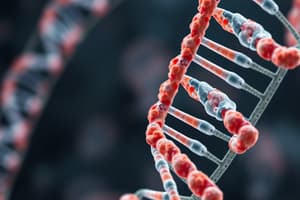Podcast
Questions and Answers
What is helicase?
What is helicase?
- A strand of DNA being replicated continuously
- An enzyme that removes all the primers in the lagging strand
- An enzyme that binds to the primer
- The protein that separates the two strands of DNA (correct)
What is a replication fork?
What is a replication fork?
The area where the replication of DNA will take place.
What does DNA polymerase do?
What does DNA polymerase do?
It binds to the primer and makes a new strand of DNA.
Which direction is the leading strand replicated?
Which direction is the leading strand replicated?
What is the lagging strand?
What is the lagging strand?
What are Okazaki fragments?
What are Okazaki fragments?
What is exonuclease?
What is exonuclease?
What does ligase do?
What does ligase do?
What does semiconservative mean in the context of DNA replication?
What does semiconservative mean in the context of DNA replication?
What is the origin of replication?
What is the origin of replication?
What direction does DNA polymerase work?
What direction does DNA polymerase work?
Flashcards are hidden until you start studying
Study Notes
DNA Replication Fork Terms
-
Helicase: A protein responsible for unwinding the DNA double helix, allowing the two strands to separate during replication.
-
Replication Fork: The structure formed during DNA replication, where the two separated strands resemble a fork, indicating where the replication occurs.
-
DNA Polymerase: An essential enzyme that synthesizes new DNA strands by binding to RNA primers. It adds nucleotides in the 5' to 3' direction and fills gaps left by primers.
-
Leading Strand: This strand of DNA is synthesized continuously in the 5' to 3' direction, allowing for uninterrupted replication by DNA polymerase.
-
Lagging Strand: Unlike the leading strand, this strand is synthesized discontinuously due to its opposite orientation relative to the replication fork.
-
Okazaki Fragments: Short segments of DNA produced on the lagging strand due to its reverse direction; each fragment is initiated by an RNA primer.
-
Exonuclease: An enzyme that removes RNA primers from the lagging strand after replication to ensure only DNA remains.
-
Ligase: An enzyme that joins Okazaki fragments together and seals nicks in the DNA, completing the formation of a continuous double-stranded DNA molecule.
-
Semiconservative: Describes the mechanism of DNA replication, where each new DNA molecule consists of one original (conserved) strand and one newly synthesized strand.
-
Origin of Replication: The specific site on the DNA where replication begins, triggering the unwinding of the double helix.
-
5' to 3' Direction: The orientation in which DNA polymerase adds nucleotides, advancing the elongation of the new DNA strand.
Studying That Suits You
Use AI to generate personalized quizzes and flashcards to suit your learning preferences.




